Report on Effective Teamwork and Communication Skills: Case Study
VerifiedAdded on 2023/06/18
|9
|2698
|299
Report
AI Summary
This report explores strategies for effective teamwork and communication, focusing on the "Mario and Pedro" case study. It identifies the reasons for misunderstanding between Maria and Pedro, attributing it to communication barriers and differing communication styles. The report uses the Shannon-Weaver model to explain the confusion, highlighting how the message was misinterpreted. It suggests prevention strategies, including active listening, clear communication, and feedback, and proposes the Barnlund's Transactional Model of Communication as a way to avoid such misunderstandings by emphasizing reciprocal feedback. The report concludes that strong communication is essential for building effective teams and achieving common goals, while understanding communication models helps in preventing misinterpretations.
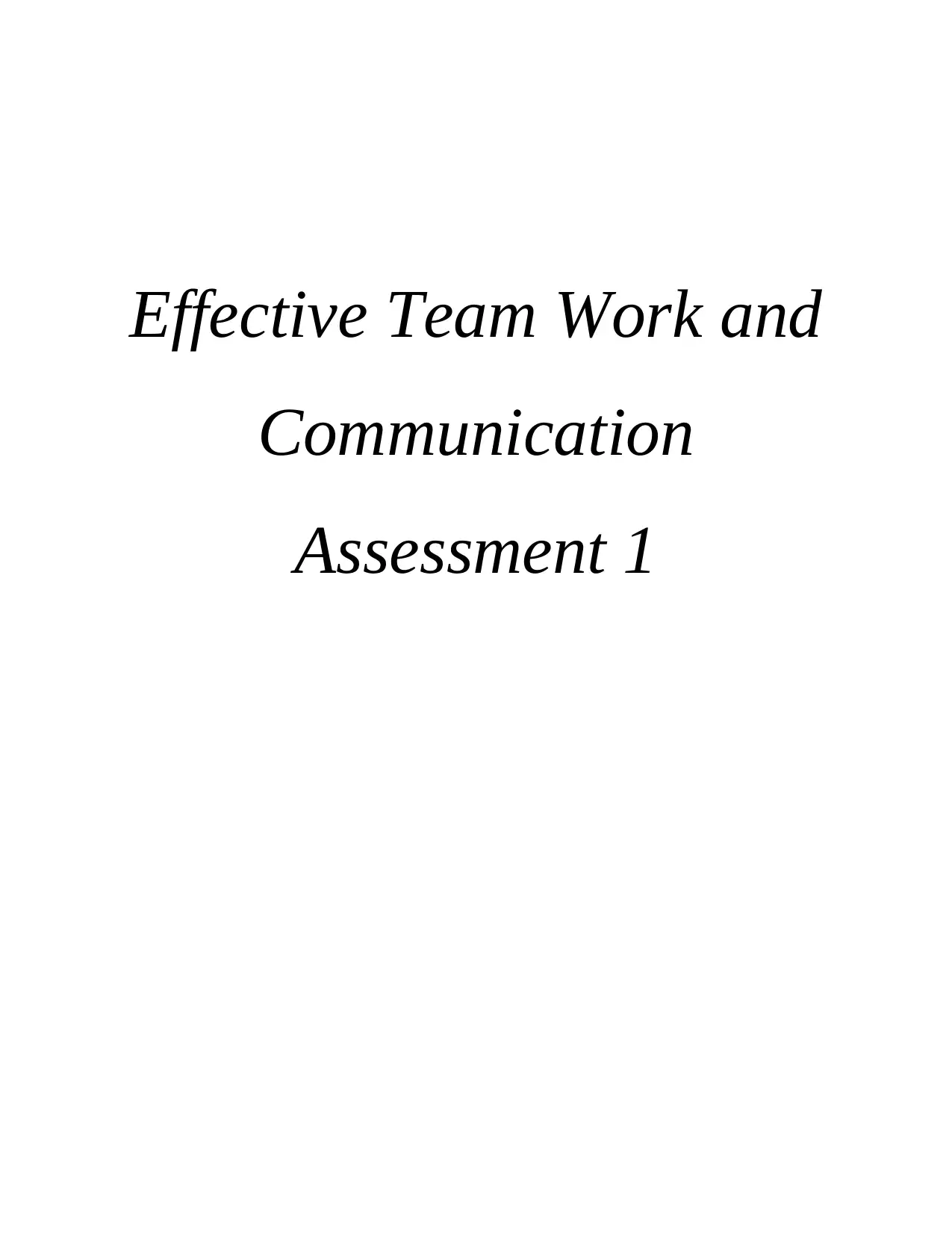
Effective Team Work and
Communication
Assessment 1
Communication
Assessment 1
Paraphrase This Document
Need a fresh take? Get an instant paraphrase of this document with our AI Paraphraser
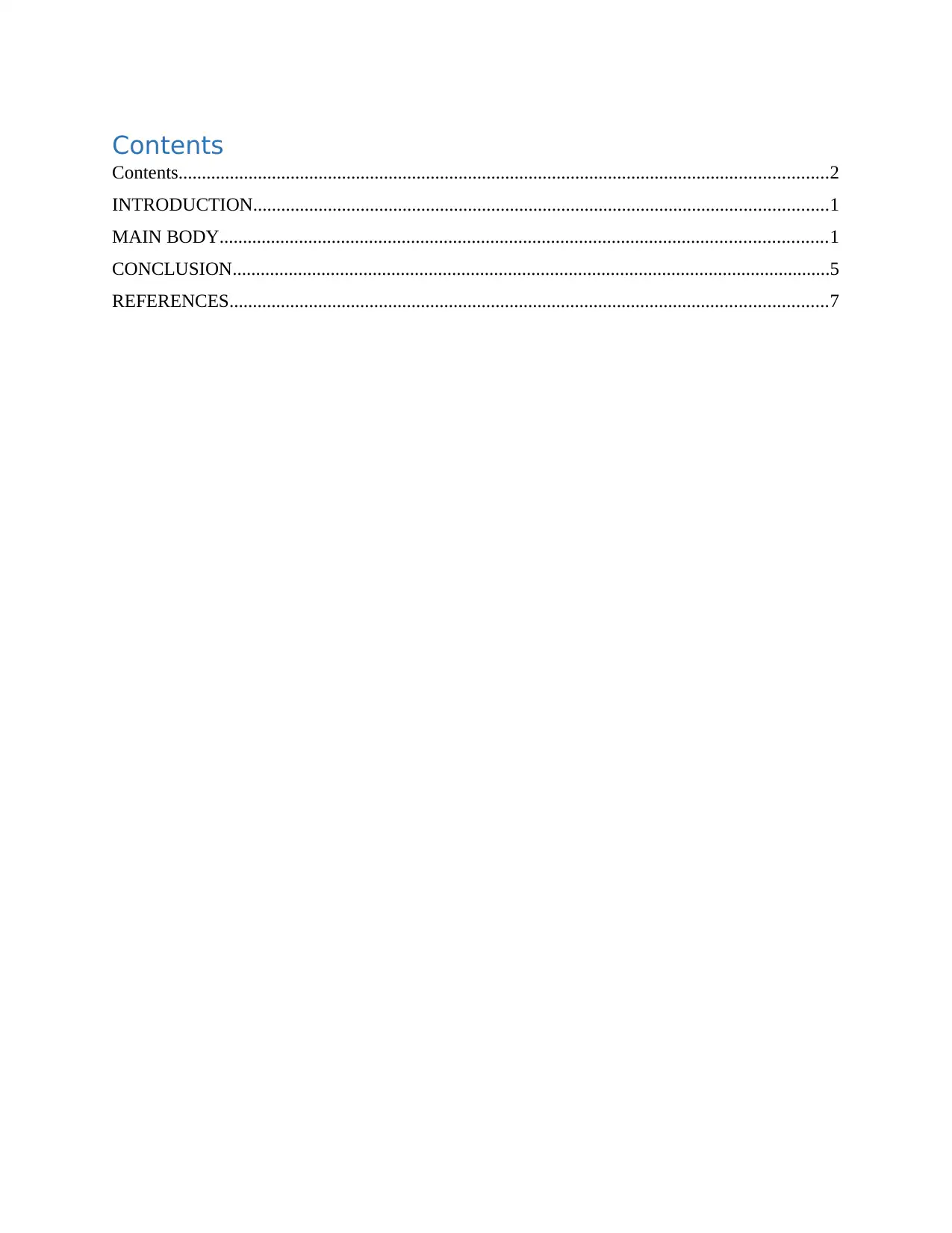
Contents
Contents...........................................................................................................................................2
INTRODUCTION...........................................................................................................................1
MAIN BODY..................................................................................................................................1
CONCLUSION................................................................................................................................5
REFERENCES................................................................................................................................7
Contents...........................................................................................................................................2
INTRODUCTION...........................................................................................................................1
MAIN BODY..................................................................................................................................1
CONCLUSION................................................................................................................................5
REFERENCES................................................................................................................................7
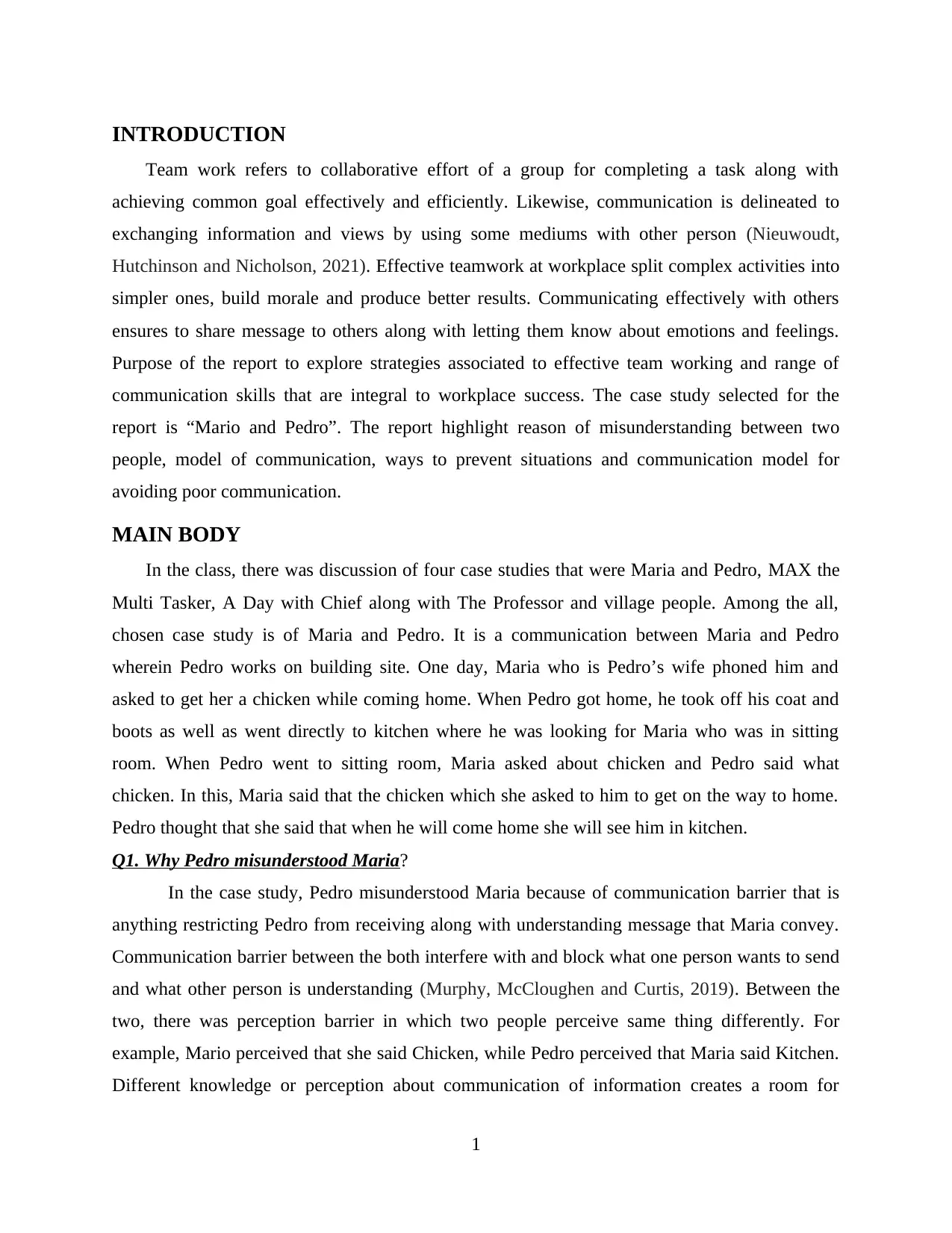
INTRODUCTION
Team work refers to collaborative effort of a group for completing a task along with
achieving common goal effectively and efficiently. Likewise, communication is delineated to
exchanging information and views by using some mediums with other person (Nieuwoudt,
Hutchinson and Nicholson, 2021). Effective teamwork at workplace split complex activities into
simpler ones, build morale and produce better results. Communicating effectively with others
ensures to share message to others along with letting them know about emotions and feelings.
Purpose of the report to explore strategies associated to effective team working and range of
communication skills that are integral to workplace success. The case study selected for the
report is “Mario and Pedro”. The report highlight reason of misunderstanding between two
people, model of communication, ways to prevent situations and communication model for
avoiding poor communication.
MAIN BODY
In the class, there was discussion of four case studies that were Maria and Pedro, MAX the
Multi Tasker, A Day with Chief along with The Professor and village people. Among the all,
chosen case study is of Maria and Pedro. It is a communication between Maria and Pedro
wherein Pedro works on building site. One day, Maria who is Pedro’s wife phoned him and
asked to get her a chicken while coming home. When Pedro got home, he took off his coat and
boots as well as went directly to kitchen where he was looking for Maria who was in sitting
room. When Pedro went to sitting room, Maria asked about chicken and Pedro said what
chicken. In this, Maria said that the chicken which she asked to him to get on the way to home.
Pedro thought that she said that when he will come home she will see him in kitchen.
Q1. Why Pedro misunderstood Maria?
In the case study, Pedro misunderstood Maria because of communication barrier that is
anything restricting Pedro from receiving along with understanding message that Maria convey.
Communication barrier between the both interfere with and block what one person wants to send
and what other person is understanding (Murphy, McCloughen and Curtis, 2019). Between the
two, there was perception barrier in which two people perceive same thing differently. For
example, Mario perceived that she said Chicken, while Pedro perceived that Maria said Kitchen.
Different knowledge or perception about communication of information creates a room for
1
Team work refers to collaborative effort of a group for completing a task along with
achieving common goal effectively and efficiently. Likewise, communication is delineated to
exchanging information and views by using some mediums with other person (Nieuwoudt,
Hutchinson and Nicholson, 2021). Effective teamwork at workplace split complex activities into
simpler ones, build morale and produce better results. Communicating effectively with others
ensures to share message to others along with letting them know about emotions and feelings.
Purpose of the report to explore strategies associated to effective team working and range of
communication skills that are integral to workplace success. The case study selected for the
report is “Mario and Pedro”. The report highlight reason of misunderstanding between two
people, model of communication, ways to prevent situations and communication model for
avoiding poor communication.
MAIN BODY
In the class, there was discussion of four case studies that were Maria and Pedro, MAX the
Multi Tasker, A Day with Chief along with The Professor and village people. Among the all,
chosen case study is of Maria and Pedro. It is a communication between Maria and Pedro
wherein Pedro works on building site. One day, Maria who is Pedro’s wife phoned him and
asked to get her a chicken while coming home. When Pedro got home, he took off his coat and
boots as well as went directly to kitchen where he was looking for Maria who was in sitting
room. When Pedro went to sitting room, Maria asked about chicken and Pedro said what
chicken. In this, Maria said that the chicken which she asked to him to get on the way to home.
Pedro thought that she said that when he will come home she will see him in kitchen.
Q1. Why Pedro misunderstood Maria?
In the case study, Pedro misunderstood Maria because of communication barrier that is
anything restricting Pedro from receiving along with understanding message that Maria convey.
Communication barrier between the both interfere with and block what one person wants to send
and what other person is understanding (Murphy, McCloughen and Curtis, 2019). Between the
two, there was perception barrier in which two people perceive same thing differently. For
example, Mario perceived that she said Chicken, while Pedro perceived that Maria said Kitchen.
Different knowledge or perception about communication of information creates a room for
1
⊘ This is a preview!⊘
Do you want full access?
Subscribe today to unlock all pages.

Trusted by 1+ million students worldwide
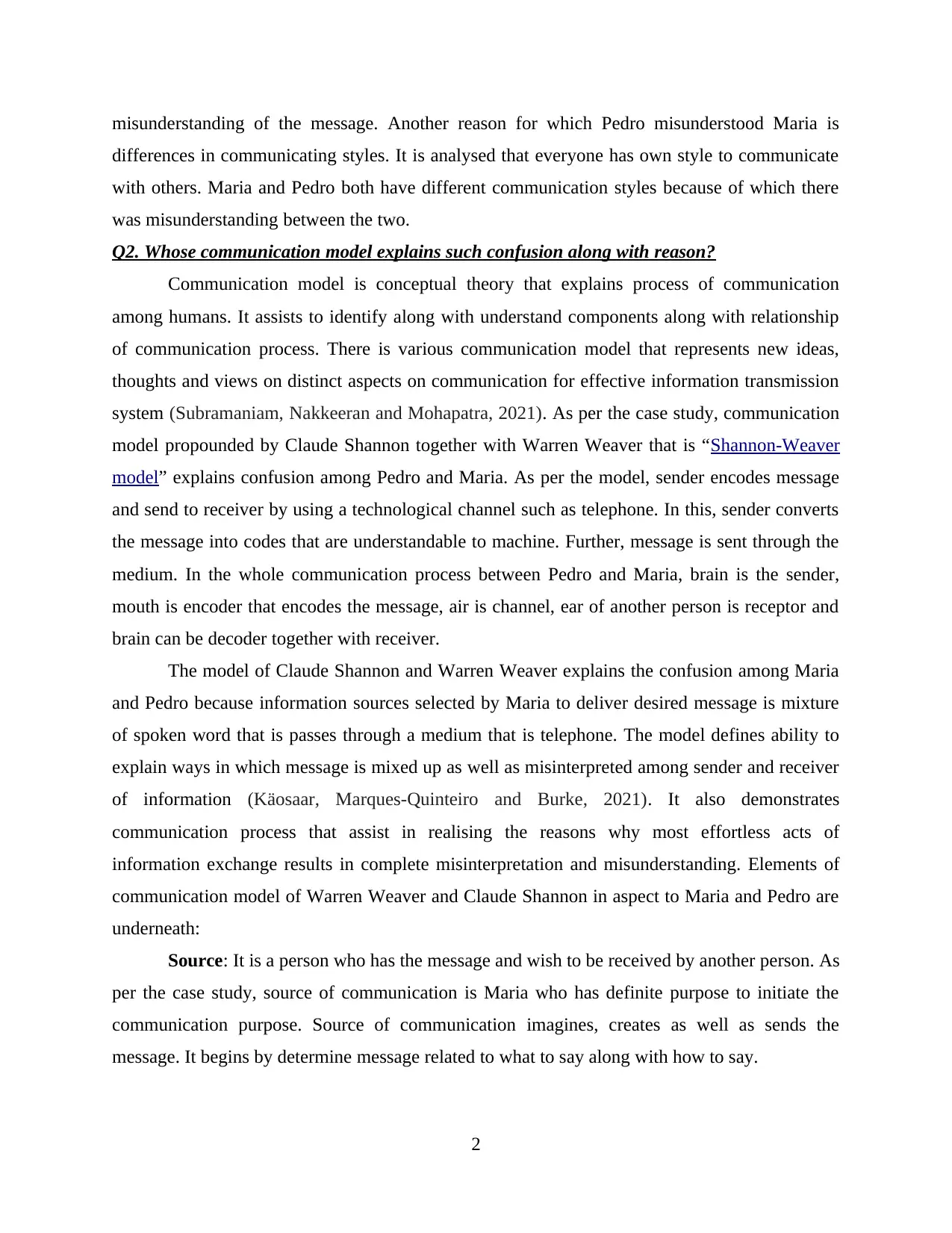
misunderstanding of the message. Another reason for which Pedro misunderstood Maria is
differences in communicating styles. It is analysed that everyone has own style to communicate
with others. Maria and Pedro both have different communication styles because of which there
was misunderstanding between the two.
Q2. Whose communication model explains such confusion along with reason?
Communication model is conceptual theory that explains process of communication
among humans. It assists to identify along with understand components along with relationship
of communication process. There is various communication model that represents new ideas,
thoughts and views on distinct aspects on communication for effective information transmission
system (Subramaniam, Nakkeeran and Mohapatra, 2021). As per the case study, communication
model propounded by Claude Shannon together with Warren Weaver that is “Shannon-Weaver
model” explains confusion among Pedro and Maria. As per the model, sender encodes message
and send to receiver by using a technological channel such as telephone. In this, sender converts
the message into codes that are understandable to machine. Further, message is sent through the
medium. In the whole communication process between Pedro and Maria, brain is the sender,
mouth is encoder that encodes the message, air is channel, ear of another person is receptor and
brain can be decoder together with receiver.
The model of Claude Shannon and Warren Weaver explains the confusion among Maria
and Pedro because information sources selected by Maria to deliver desired message is mixture
of spoken word that is passes through a medium that is telephone. The model defines ability to
explain ways in which message is mixed up as well as misinterpreted among sender and receiver
of information (Käosaar, Marques-Quinteiro and Burke, 2021). It also demonstrates
communication process that assist in realising the reasons why most effortless acts of
information exchange results in complete misinterpretation and misunderstanding. Elements of
communication model of Warren Weaver and Claude Shannon in aspect to Maria and Pedro are
underneath:
Source: It is a person who has the message and wish to be received by another person. As
per the case study, source of communication is Maria who has definite purpose to initiate the
communication purpose. Source of communication imagines, creates as well as sends the
message. It begins by determine message related to what to say along with how to say.
2
differences in communicating styles. It is analysed that everyone has own style to communicate
with others. Maria and Pedro both have different communication styles because of which there
was misunderstanding between the two.
Q2. Whose communication model explains such confusion along with reason?
Communication model is conceptual theory that explains process of communication
among humans. It assists to identify along with understand components along with relationship
of communication process. There is various communication model that represents new ideas,
thoughts and views on distinct aspects on communication for effective information transmission
system (Subramaniam, Nakkeeran and Mohapatra, 2021). As per the case study, communication
model propounded by Claude Shannon together with Warren Weaver that is “Shannon-Weaver
model” explains confusion among Pedro and Maria. As per the model, sender encodes message
and send to receiver by using a technological channel such as telephone. In this, sender converts
the message into codes that are understandable to machine. Further, message is sent through the
medium. In the whole communication process between Pedro and Maria, brain is the sender,
mouth is encoder that encodes the message, air is channel, ear of another person is receptor and
brain can be decoder together with receiver.
The model of Claude Shannon and Warren Weaver explains the confusion among Maria
and Pedro because information sources selected by Maria to deliver desired message is mixture
of spoken word that is passes through a medium that is telephone. The model defines ability to
explain ways in which message is mixed up as well as misinterpreted among sender and receiver
of information (Käosaar, Marques-Quinteiro and Burke, 2021). It also demonstrates
communication process that assist in realising the reasons why most effortless acts of
information exchange results in complete misinterpretation and misunderstanding. Elements of
communication model of Warren Weaver and Claude Shannon in aspect to Maria and Pedro are
underneath:
Source: It is a person who has the message and wish to be received by another person. As
per the case study, source of communication is Maria who has definite purpose to initiate the
communication purpose. Source of communication imagines, creates as well as sends the
message. It begins by determine message related to what to say along with how to say.
2
Paraphrase This Document
Need a fresh take? Get an instant paraphrase of this document with our AI Paraphraser
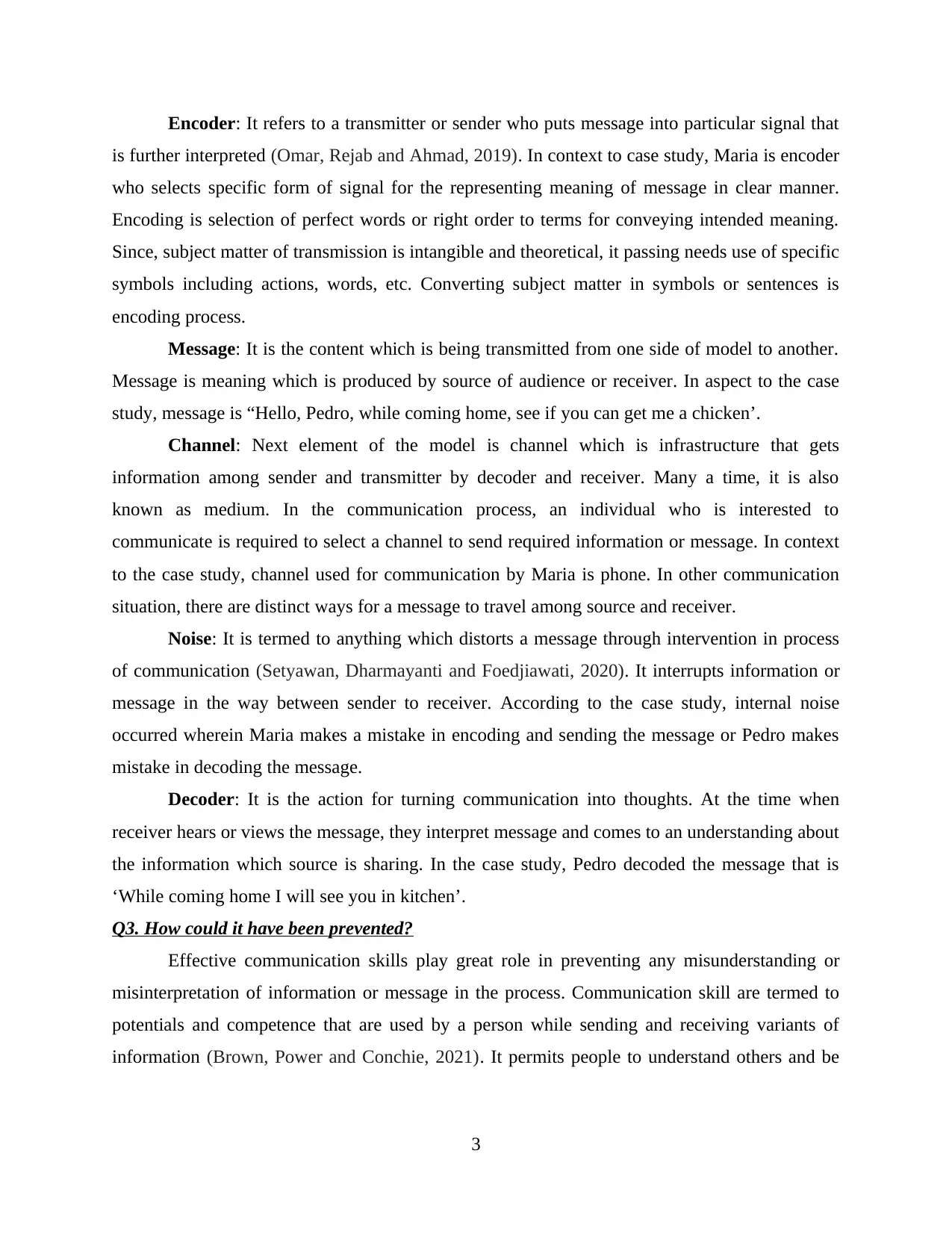
Encoder: It refers to a transmitter or sender who puts message into particular signal that
is further interpreted (Omar, Rejab and Ahmad, 2019). In context to case study, Maria is encoder
who selects specific form of signal for the representing meaning of message in clear manner.
Encoding is selection of perfect words or right order to terms for conveying intended meaning.
Since, subject matter of transmission is intangible and theoretical, it passing needs use of specific
symbols including actions, words, etc. Converting subject matter in symbols or sentences is
encoding process.
Message: It is the content which is being transmitted from one side of model to another.
Message is meaning which is produced by source of audience or receiver. In aspect to the case
study, message is “Hello, Pedro, while coming home, see if you can get me a chicken’.
Channel: Next element of the model is channel which is infrastructure that gets
information among sender and transmitter by decoder and receiver. Many a time, it is also
known as medium. In the communication process, an individual who is interested to
communicate is required to select a channel to send required information or message. In context
to the case study, channel used for communication by Maria is phone. In other communication
situation, there are distinct ways for a message to travel among source and receiver.
Noise: It is termed to anything which distorts a message through intervention in process
of communication (Setyawan, Dharmayanti and Foedjiawati, 2020). It interrupts information or
message in the way between sender to receiver. According to the case study, internal noise
occurred wherein Maria makes a mistake in encoding and sending the message or Pedro makes
mistake in decoding the message.
Decoder: It is the action for turning communication into thoughts. At the time when
receiver hears or views the message, they interpret message and comes to an understanding about
the information which source is sharing. In the case study, Pedro decoded the message that is
‘While coming home I will see you in kitchen’.
Q3. How could it have been prevented?
Effective communication skills play great role in preventing any misunderstanding or
misinterpretation of information or message in the process. Communication skill are termed to
potentials and competence that are used by a person while sending and receiving variants of
information (Brown, Power and Conchie, 2021). It permits people to understand others and be
3
is further interpreted (Omar, Rejab and Ahmad, 2019). In context to case study, Maria is encoder
who selects specific form of signal for the representing meaning of message in clear manner.
Encoding is selection of perfect words or right order to terms for conveying intended meaning.
Since, subject matter of transmission is intangible and theoretical, it passing needs use of specific
symbols including actions, words, etc. Converting subject matter in symbols or sentences is
encoding process.
Message: It is the content which is being transmitted from one side of model to another.
Message is meaning which is produced by source of audience or receiver. In aspect to the case
study, message is “Hello, Pedro, while coming home, see if you can get me a chicken’.
Channel: Next element of the model is channel which is infrastructure that gets
information among sender and transmitter by decoder and receiver. Many a time, it is also
known as medium. In the communication process, an individual who is interested to
communicate is required to select a channel to send required information or message. In context
to the case study, channel used for communication by Maria is phone. In other communication
situation, there are distinct ways for a message to travel among source and receiver.
Noise: It is termed to anything which distorts a message through intervention in process
of communication (Setyawan, Dharmayanti and Foedjiawati, 2020). It interrupts information or
message in the way between sender to receiver. According to the case study, internal noise
occurred wherein Maria makes a mistake in encoding and sending the message or Pedro makes
mistake in decoding the message.
Decoder: It is the action for turning communication into thoughts. At the time when
receiver hears or views the message, they interpret message and comes to an understanding about
the information which source is sharing. In the case study, Pedro decoded the message that is
‘While coming home I will see you in kitchen’.
Q3. How could it have been prevented?
Effective communication skills play great role in preventing any misunderstanding or
misinterpretation of information or message in the process. Communication skill are termed to
potentials and competence that are used by a person while sending and receiving variants of
information (Brown, Power and Conchie, 2021). It permits people to understand others and be
3
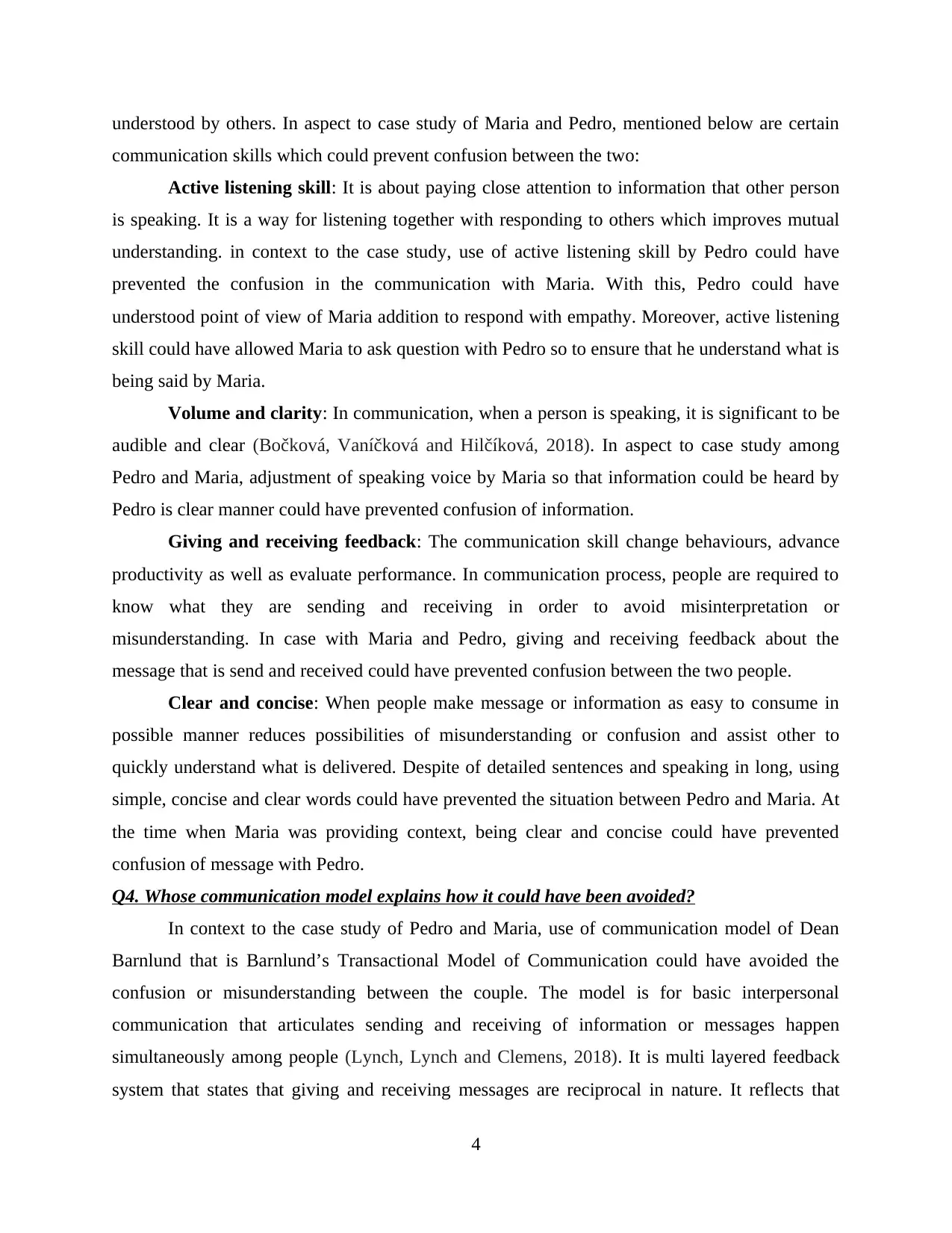
understood by others. In aspect to case study of Maria and Pedro, mentioned below are certain
communication skills which could prevent confusion between the two:
Active listening skill: It is about paying close attention to information that other person
is speaking. It is a way for listening together with responding to others which improves mutual
understanding. in context to the case study, use of active listening skill by Pedro could have
prevented the confusion in the communication with Maria. With this, Pedro could have
understood point of view of Maria addition to respond with empathy. Moreover, active listening
skill could have allowed Maria to ask question with Pedro so to ensure that he understand what is
being said by Maria.
Volume and clarity: In communication, when a person is speaking, it is significant to be
audible and clear (Bočková, Vaníčková and Hilčíková, 2018). In aspect to case study among
Pedro and Maria, adjustment of speaking voice by Maria so that information could be heard by
Pedro is clear manner could have prevented confusion of information.
Giving and receiving feedback: The communication skill change behaviours, advance
productivity as well as evaluate performance. In communication process, people are required to
know what they are sending and receiving in order to avoid misinterpretation or
misunderstanding. In case with Maria and Pedro, giving and receiving feedback about the
message that is send and received could have prevented confusion between the two people.
Clear and concise: When people make message or information as easy to consume in
possible manner reduces possibilities of misunderstanding or confusion and assist other to
quickly understand what is delivered. Despite of detailed sentences and speaking in long, using
simple, concise and clear words could have prevented the situation between Pedro and Maria. At
the time when Maria was providing context, being clear and concise could have prevented
confusion of message with Pedro.
Q4. Whose communication model explains how it could have been avoided?
In context to the case study of Pedro and Maria, use of communication model of Dean
Barnlund that is Barnlund’s Transactional Model of Communication could have avoided the
confusion or misunderstanding between the couple. The model is for basic interpersonal
communication that articulates sending and receiving of information or messages happen
simultaneously among people (Lynch, Lynch and Clemens, 2018). It is multi layered feedback
system that states that giving and receiving messages are reciprocal in nature. It reflects that
4
communication skills which could prevent confusion between the two:
Active listening skill: It is about paying close attention to information that other person
is speaking. It is a way for listening together with responding to others which improves mutual
understanding. in context to the case study, use of active listening skill by Pedro could have
prevented the confusion in the communication with Maria. With this, Pedro could have
understood point of view of Maria addition to respond with empathy. Moreover, active listening
skill could have allowed Maria to ask question with Pedro so to ensure that he understand what is
being said by Maria.
Volume and clarity: In communication, when a person is speaking, it is significant to be
audible and clear (Bočková, Vaníčková and Hilčíková, 2018). In aspect to case study among
Pedro and Maria, adjustment of speaking voice by Maria so that information could be heard by
Pedro is clear manner could have prevented confusion of information.
Giving and receiving feedback: The communication skill change behaviours, advance
productivity as well as evaluate performance. In communication process, people are required to
know what they are sending and receiving in order to avoid misinterpretation or
misunderstanding. In case with Maria and Pedro, giving and receiving feedback about the
message that is send and received could have prevented confusion between the two people.
Clear and concise: When people make message or information as easy to consume in
possible manner reduces possibilities of misunderstanding or confusion and assist other to
quickly understand what is delivered. Despite of detailed sentences and speaking in long, using
simple, concise and clear words could have prevented the situation between Pedro and Maria. At
the time when Maria was providing context, being clear and concise could have prevented
confusion of message with Pedro.
Q4. Whose communication model explains how it could have been avoided?
In context to the case study of Pedro and Maria, use of communication model of Dean
Barnlund that is Barnlund’s Transactional Model of Communication could have avoided the
confusion or misunderstanding between the couple. The model is for basic interpersonal
communication that articulates sending and receiving of information or messages happen
simultaneously among people (Lynch, Lynch and Clemens, 2018). It is multi layered feedback
system that states that giving and receiving messages are reciprocal in nature. It reflects that
4
⊘ This is a preview!⊘
Do you want full access?
Subscribe today to unlock all pages.

Trusted by 1+ million students worldwide
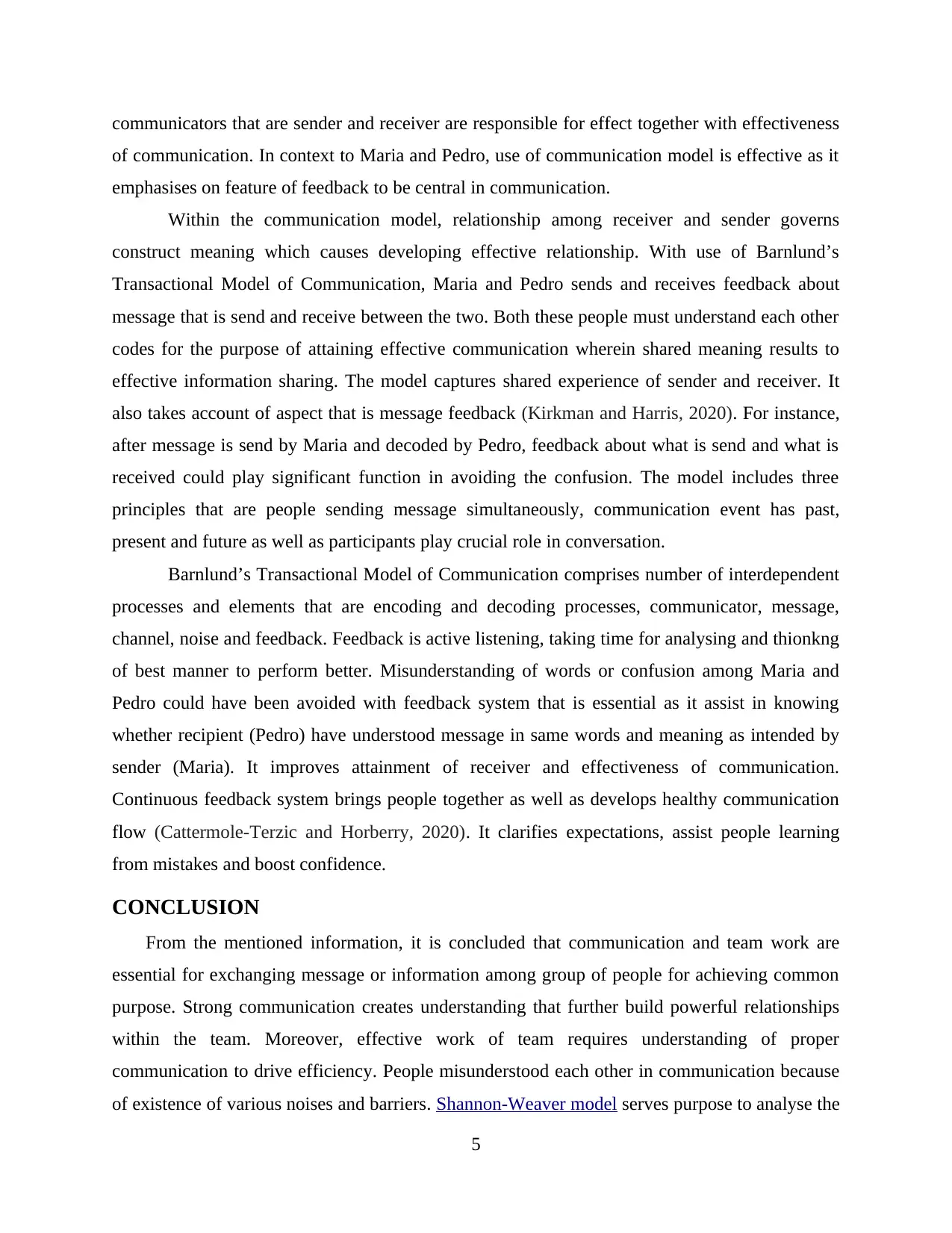
communicators that are sender and receiver are responsible for effect together with effectiveness
of communication. In context to Maria and Pedro, use of communication model is effective as it
emphasises on feature of feedback to be central in communication.
Within the communication model, relationship among receiver and sender governs
construct meaning which causes developing effective relationship. With use of Barnlund’s
Transactional Model of Communication, Maria and Pedro sends and receives feedback about
message that is send and receive between the two. Both these people must understand each other
codes for the purpose of attaining effective communication wherein shared meaning results to
effective information sharing. The model captures shared experience of sender and receiver. It
also takes account of aspect that is message feedback (Kirkman and Harris, 2020). For instance,
after message is send by Maria and decoded by Pedro, feedback about what is send and what is
received could play significant function in avoiding the confusion. The model includes three
principles that are people sending message simultaneously, communication event has past,
present and future as well as participants play crucial role in conversation.
Barnlund’s Transactional Model of Communication comprises number of interdependent
processes and elements that are encoding and decoding processes, communicator, message,
channel, noise and feedback. Feedback is active listening, taking time for analysing and thionkng
of best manner to perform better. Misunderstanding of words or confusion among Maria and
Pedro could have been avoided with feedback system that is essential as it assist in knowing
whether recipient (Pedro) have understood message in same words and meaning as intended by
sender (Maria). It improves attainment of receiver and effectiveness of communication.
Continuous feedback system brings people together as well as develops healthy communication
flow (Cattermole-Terzic and Horberry, 2020). It clarifies expectations, assist people learning
from mistakes and boost confidence.
CONCLUSION
From the mentioned information, it is concluded that communication and team work are
essential for exchanging message or information among group of people for achieving common
purpose. Strong communication creates understanding that further build powerful relationships
within the team. Moreover, effective work of team requires understanding of proper
communication to drive efficiency. People misunderstood each other in communication because
of existence of various noises and barriers. Shannon-Weaver model serves purpose to analyse the
5
of communication. In context to Maria and Pedro, use of communication model is effective as it
emphasises on feature of feedback to be central in communication.
Within the communication model, relationship among receiver and sender governs
construct meaning which causes developing effective relationship. With use of Barnlund’s
Transactional Model of Communication, Maria and Pedro sends and receives feedback about
message that is send and receive between the two. Both these people must understand each other
codes for the purpose of attaining effective communication wherein shared meaning results to
effective information sharing. The model captures shared experience of sender and receiver. It
also takes account of aspect that is message feedback (Kirkman and Harris, 2020). For instance,
after message is send by Maria and decoded by Pedro, feedback about what is send and what is
received could play significant function in avoiding the confusion. The model includes three
principles that are people sending message simultaneously, communication event has past,
present and future as well as participants play crucial role in conversation.
Barnlund’s Transactional Model of Communication comprises number of interdependent
processes and elements that are encoding and decoding processes, communicator, message,
channel, noise and feedback. Feedback is active listening, taking time for analysing and thionkng
of best manner to perform better. Misunderstanding of words or confusion among Maria and
Pedro could have been avoided with feedback system that is essential as it assist in knowing
whether recipient (Pedro) have understood message in same words and meaning as intended by
sender (Maria). It improves attainment of receiver and effectiveness of communication.
Continuous feedback system brings people together as well as develops healthy communication
flow (Cattermole-Terzic and Horberry, 2020). It clarifies expectations, assist people learning
from mistakes and boost confidence.
CONCLUSION
From the mentioned information, it is concluded that communication and team work are
essential for exchanging message or information among group of people for achieving common
purpose. Strong communication creates understanding that further build powerful relationships
within the team. Moreover, effective work of team requires understanding of proper
communication to drive efficiency. People misunderstood each other in communication because
of existence of various noises and barriers. Shannon-Weaver model serves purpose to analyse the
5
Paraphrase This Document
Need a fresh take? Get an instant paraphrase of this document with our AI Paraphraser

ways in which messages are sent and received in communication. To prevent confusion,
important communication skills are clear and concise, active listening, volume and clarity.
6
important communication skills are clear and concise, active listening, volume and clarity.
6
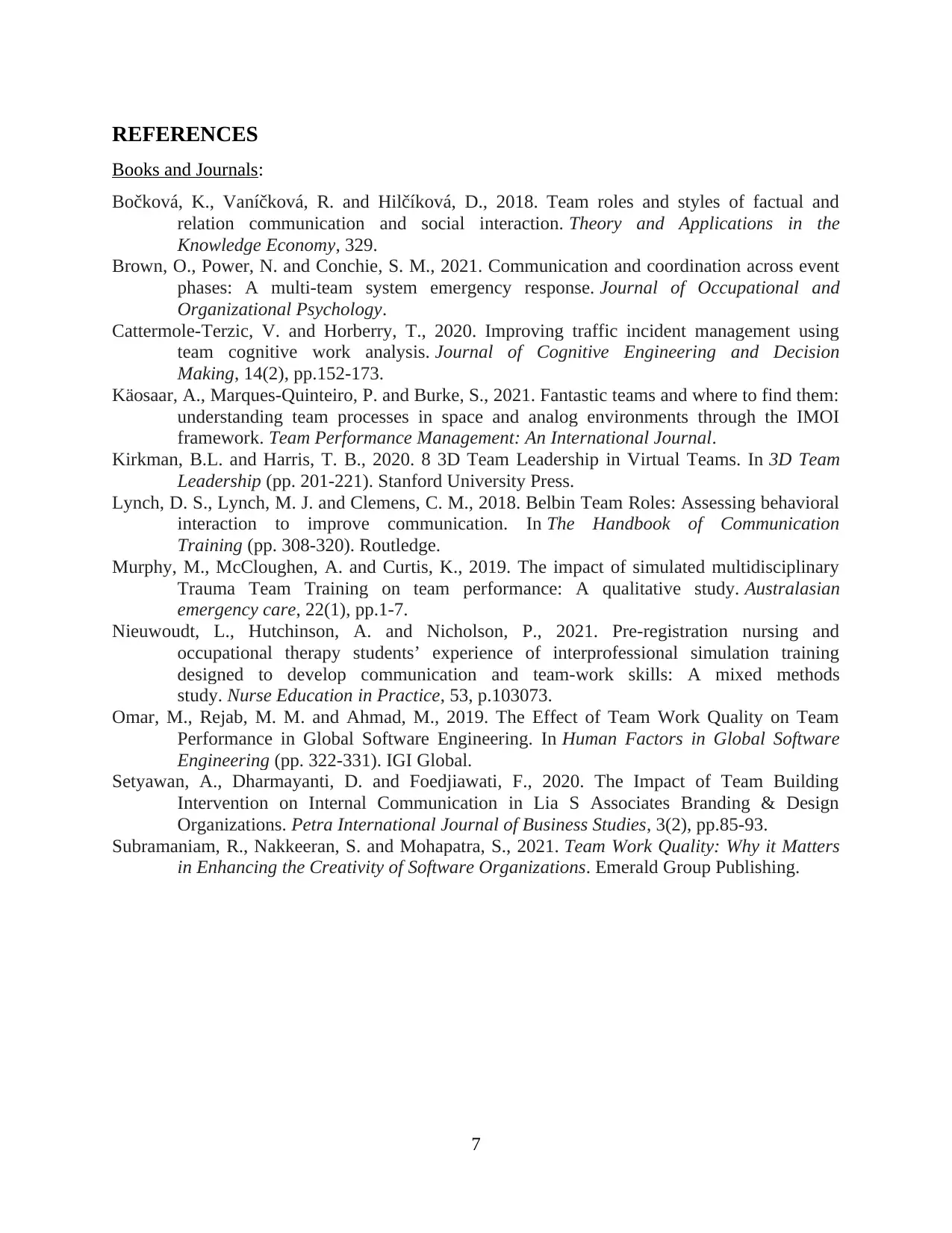
REFERENCES
Books and Journals:
Bočková, K., Vaníčková, R. and Hilčíková, D., 2018. Team roles and styles of factual and
relation communication and social interaction. Theory and Applications in the
Knowledge Economy, 329.
Brown, O., Power, N. and Conchie, S. M., 2021. Communication and coordination across event
phases: A multi‐team system emergency response. Journal of Occupational and
Organizational Psychology.
Cattermole-Terzic, V. and Horberry, T., 2020. Improving traffic incident management using
team cognitive work analysis. Journal of Cognitive Engineering and Decision
Making, 14(2), pp.152-173.
Käosaar, A., Marques-Quinteiro, P. and Burke, S., 2021. Fantastic teams and where to find them:
understanding team processes in space and analog environments through the IMOI
framework. Team Performance Management: An International Journal.
Kirkman, B.L. and Harris, T. B., 2020. 8 3D Team Leadership in Virtual Teams. In 3D Team
Leadership (pp. 201-221). Stanford University Press.
Lynch, D. S., Lynch, M. J. and Clemens, C. M., 2018. Belbin Team Roles: Assessing behavioral
interaction to improve communication. In The Handbook of Communication
Training (pp. 308-320). Routledge.
Murphy, M., McCloughen, A. and Curtis, K., 2019. The impact of simulated multidisciplinary
Trauma Team Training on team performance: A qualitative study. Australasian
emergency care, 22(1), pp.1-7.
Nieuwoudt, L., Hutchinson, A. and Nicholson, P., 2021. Pre-registration nursing and
occupational therapy students’ experience of interprofessional simulation training
designed to develop communication and team-work skills: A mixed methods
study. Nurse Education in Practice, 53, p.103073.
Omar, M., Rejab, M. M. and Ahmad, M., 2019. The Effect of Team Work Quality on Team
Performance in Global Software Engineering. In Human Factors in Global Software
Engineering (pp. 322-331). IGI Global.
Setyawan, A., Dharmayanti, D. and Foedjiawati, F., 2020. The Impact of Team Building
Intervention on Internal Communication in Lia S Associates Branding & Design
Organizations. Petra International Journal of Business Studies, 3(2), pp.85-93.
Subramaniam, R., Nakkeeran, S. and Mohapatra, S., 2021. Team Work Quality: Why it Matters
in Enhancing the Creativity of Software Organizations. Emerald Group Publishing.
7
Books and Journals:
Bočková, K., Vaníčková, R. and Hilčíková, D., 2018. Team roles and styles of factual and
relation communication and social interaction. Theory and Applications in the
Knowledge Economy, 329.
Brown, O., Power, N. and Conchie, S. M., 2021. Communication and coordination across event
phases: A multi‐team system emergency response. Journal of Occupational and
Organizational Psychology.
Cattermole-Terzic, V. and Horberry, T., 2020. Improving traffic incident management using
team cognitive work analysis. Journal of Cognitive Engineering and Decision
Making, 14(2), pp.152-173.
Käosaar, A., Marques-Quinteiro, P. and Burke, S., 2021. Fantastic teams and where to find them:
understanding team processes in space and analog environments through the IMOI
framework. Team Performance Management: An International Journal.
Kirkman, B.L. and Harris, T. B., 2020. 8 3D Team Leadership in Virtual Teams. In 3D Team
Leadership (pp. 201-221). Stanford University Press.
Lynch, D. S., Lynch, M. J. and Clemens, C. M., 2018. Belbin Team Roles: Assessing behavioral
interaction to improve communication. In The Handbook of Communication
Training (pp. 308-320). Routledge.
Murphy, M., McCloughen, A. and Curtis, K., 2019. The impact of simulated multidisciplinary
Trauma Team Training on team performance: A qualitative study. Australasian
emergency care, 22(1), pp.1-7.
Nieuwoudt, L., Hutchinson, A. and Nicholson, P., 2021. Pre-registration nursing and
occupational therapy students’ experience of interprofessional simulation training
designed to develop communication and team-work skills: A mixed methods
study. Nurse Education in Practice, 53, p.103073.
Omar, M., Rejab, M. M. and Ahmad, M., 2019. The Effect of Team Work Quality on Team
Performance in Global Software Engineering. In Human Factors in Global Software
Engineering (pp. 322-331). IGI Global.
Setyawan, A., Dharmayanti, D. and Foedjiawati, F., 2020. The Impact of Team Building
Intervention on Internal Communication in Lia S Associates Branding & Design
Organizations. Petra International Journal of Business Studies, 3(2), pp.85-93.
Subramaniam, R., Nakkeeran, S. and Mohapatra, S., 2021. Team Work Quality: Why it Matters
in Enhancing the Creativity of Software Organizations. Emerald Group Publishing.
7
⊘ This is a preview!⊘
Do you want full access?
Subscribe today to unlock all pages.

Trusted by 1+ million students worldwide
1 out of 9
Related Documents
Your All-in-One AI-Powered Toolkit for Academic Success.
+13062052269
info@desklib.com
Available 24*7 on WhatsApp / Email
![[object Object]](/_next/static/media/star-bottom.7253800d.svg)
Unlock your academic potential
Copyright © 2020–2025 A2Z Services. All Rights Reserved. Developed and managed by ZUCOL.


